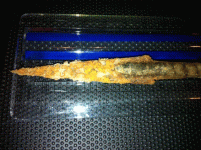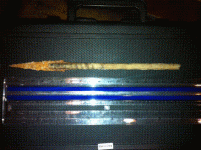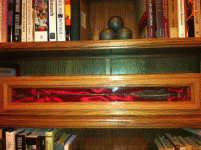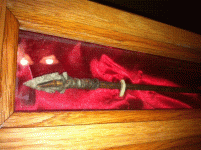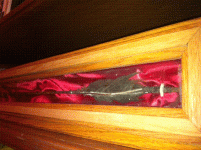Goat and KP,
Like I said, I wish I could tell you I found this one, but actually bought it from a collector. It was in a collection from South Dakota. It is found on or near the Pine Ridge Reservation. It's 7 1/2" long. The point is heavily corroded, but I wouldn't dare attempt to buff or sand it.
However, reading between the lines, I think I have something that might intererst both of you. If I'm hearing you, it sounds like you might be interested in seeing an intact arrow. Indeed, they do exist. I have two arrows from the desert Southwest. They were in the collection of one of my patients who collected art. Both arrows are right at 24" (61 cm). These ended up in his collection about 40 years ago, and he never got around to displaying them. He became quite ill a few years ago, and presented both arrows to me as a gift, along with a clay vessel. Pictured below is one of the arrows. These are not metal points, but they have been verified by an archaeologist from the University of Oklahoma. He suggested that they were probably closer to 200 years old, and originated somewhere in the desert Southwest. This was also told to me by the previous owner, as he acquired them at auction in the Four-Corners area. The display case has them straightened out, but actually the shafts are bowed terribly when not affixed to the case backing. The points are snug and very much intact. The weakest feature of both arrows seems to be the fletching. The feathers, as you can see, are fragile and not well attached. The other piece is stored securely in my office.
These are probably my most prized possessions of anthropological interest. Their story is important to me not just for the beauty and history of the pieces, but partly because of the gracious manner in which they were given to me.
I hope I didn't go too far beyond the scope of your subject in posting these, but I had a feeling both of you gentlemen might like seeing an intact, authentic arrow of 150 to 200 years ago.




